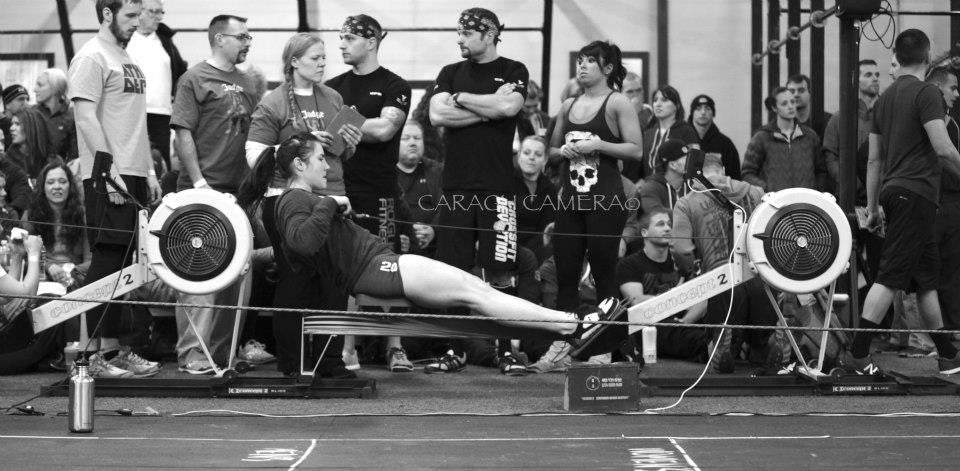Part 1 and 2 of this series looked at rowing pacing—Pacing 101, as well as pacing strategies for multi-modal CrossFit workouts.
The latter pieces considered how to pace when the rowing machine is on the meters setting. When a workout is in calories, though, the story changes completely...Or at least changes considerably.
How To Approach A Calorie Row
Like with meters, your first step is to figure out your intended speed for any given workout
It's easy to do this if you already understand how to pace a row when you’re measuring your speed in meters. Then all you have to do is convert your split time in meters to its equivalent calories per hour speed.
So for example, if you know you want to hold a 2:00/500m split for a 100-calorie piece on the rowing machine, before you start rowing blindly and hoping for the best, figure out how this converts to calories per hour. In this case, a 2:00 split is equivalent to 997 calories per hour. So you’re best aiming to hit around 1,000 calories per hour, give or take, during your 100 calorie piece.
Check out this graph, which shows calorie equivalents for splits ranging from 1:20 to 2:40/500m.

One more important consideration with CALORIES:
In a recent CrossFit Journal article I wrote, the founder of Concept2 explained that when it comes to rowing in meters, you don’t get a whole lot of “bang for your buck,” so to speak.
In other words, when you consider effort in rowing, the way the rowing machine is designed (so that it factors in water resistance), means you need to work very very hard to go just a tiny bit faster. The same isn’t true of something like thrusters or power cleans, where working a bit harder pays off in your overall time. The Concept2 founder used a graph that measures effort in watts to explain this concept. Check it out here. This doesn’t mean you shouldn’t try hard on the rowing machine: It simply means if there is one place in a multi-modal workout to hold back a bit, it might be on the row as you’re probably not going to win the workout there.
When it comes to calories, though, THIS IS NOT the case. In fact, when we consider effort-to-reward during a calorie row, it looks quite similar to effort-to-reward with a movement like a power clean. Check out his graph in the CrossFit Journal article that emphasizes this point.
Slower Means More Work
On top of this, when it comes to calories, the slower you row the more work you have to do! For example, if you rowed 27 calories at a 1:20/500m split, it would take you 37 seconds and you would row 229 meters. If you rowed 27 calories at a 1:40/500m split, it would take you one minute and five seconds and you would row 323 meters. In other words, if you’re slow at a calorie row you get penalized TWICE: Once for being slower, and another time for having to row a further distance! Can you imagine doing Helen, where slower runners had to run 500 meters, while faster runners only had to run 400 meters? BRUTAL!

In meters, more time can be made up on the barbell, but this is less true when a row is in calories...
All this is to say, if you’re rowing in calories, it might be wise to row a little bit harder than you would in meters as you’ll be rewarded twice as much for your effort.
Let’s look at a couple different common CrossFit workouts with a Calorie Row.
CrossFit Open 15.5: 27-21-15-9 Row (calories) and Thrusters
First I would consider the time domain of the workout. This workout should be in and around the same time domain as your 2-km row (It took me 7:51 in 2015, which is within 30 seconds of my current 2-km row time). If the workout were in meters, I would row slower than my 2-km row time to conserve energy to hit the thrusters hard, but since the workout is in calories, I would try to aim relatively close to my 2-km split time.
This means, if I the row were in meters, I would hold around a 1:58 split on this workout, but since it’s in calories, I might aim closer to a 1:54 (meaning around 1,100 calories per hour).
CrossFit Open 14.4: AMRAP 14 minutes of: 60-calorie row, 50 toes-to-bars, 40 wall-ball shots, 30 cleans, 20 muscle-ups
If this row were in meters, I would recommend rowing very conservatively, as way more time could be gained on the toes-to-bar, walls balls, cleans and muscle-ups. Going too hard on the row would simply hurt the rest of your performance and make you slower in the end. If this row were in meters, I would hold a casual 2:00/500m split and come off the machine fresh and ready to attack the toes-to-bar. Sure, I might be a bit slower than my competitors, but maybe only 10 to 15 seconds, which could be made up in the next two minutes of the 14-minute workout.
HOWEVER, this workout being in calories means an entire minute or so could be gained by pushing a bit harder. Instead, I would row close to my 2-km row time, knowing that 60-calories at a 1:55 split is around 800-meters. I know I wouldn't be destroyed at that pace for just 800 meters.
At the end of the day, your pace is your pace and your current fitness level is your current fitness level, BUT tinkering with your speed within reason is worth considering when the row is in calories. It’s certainly worth playing around with before the 2017 Open begins.
Happy rowing!


Leave a comment: